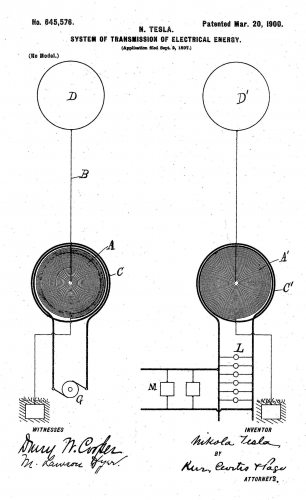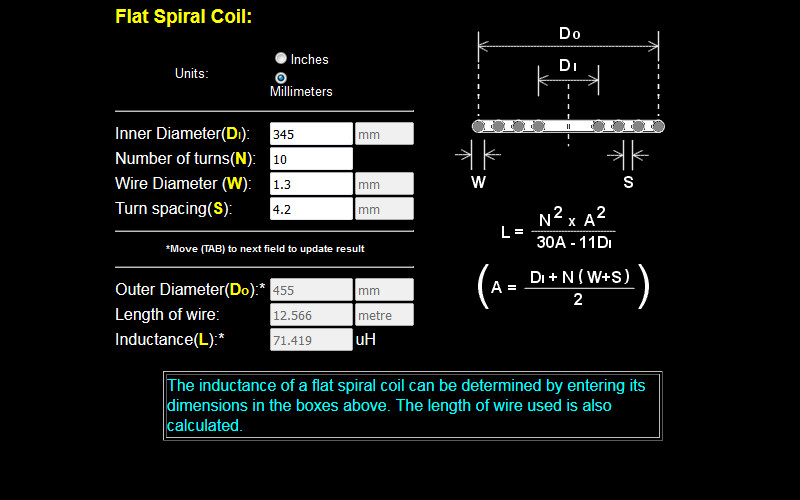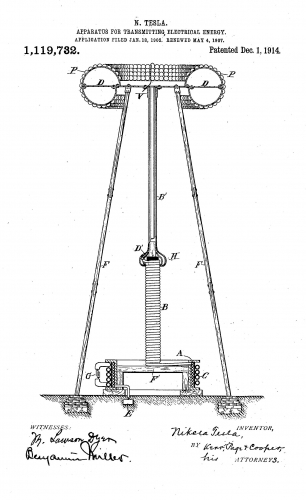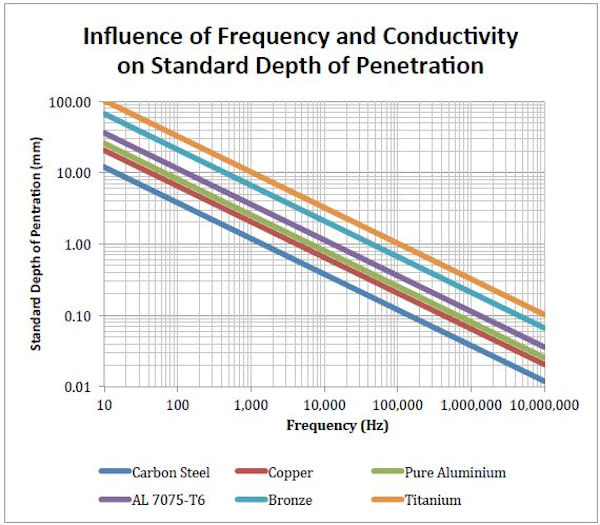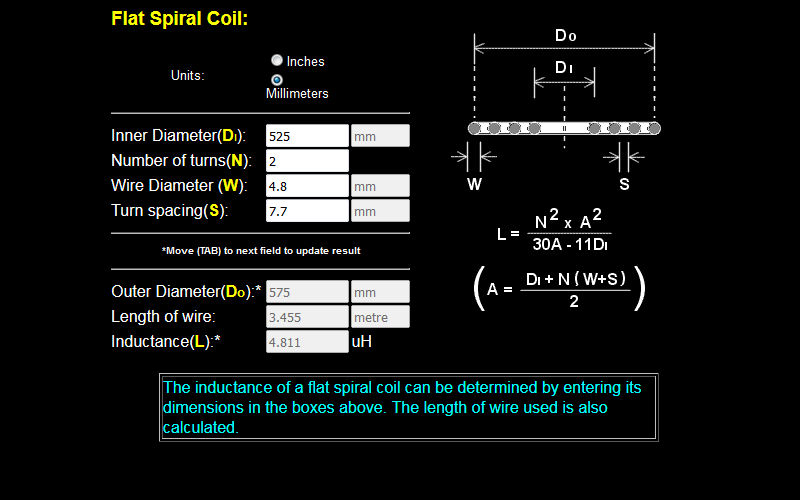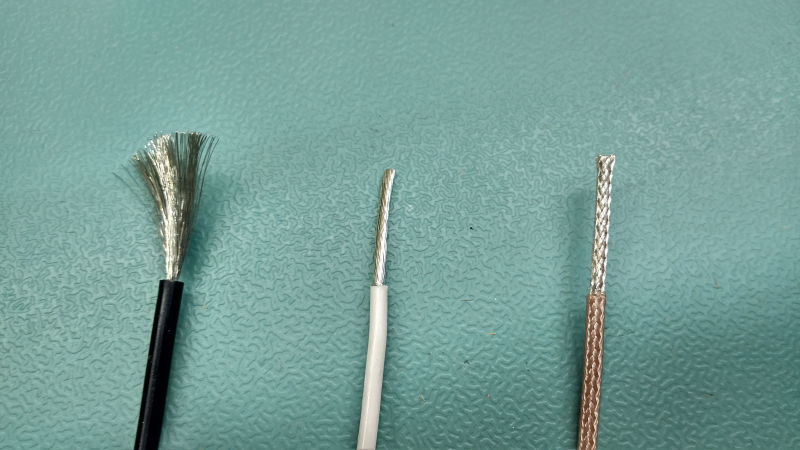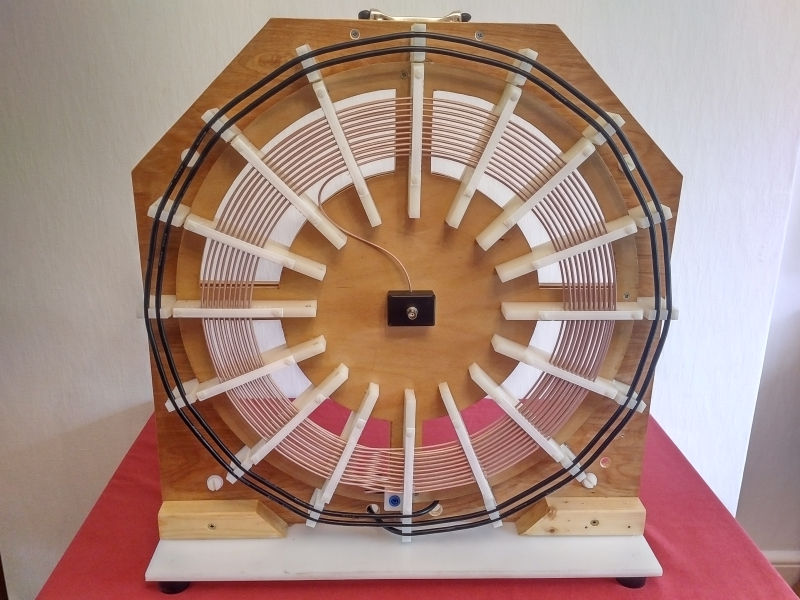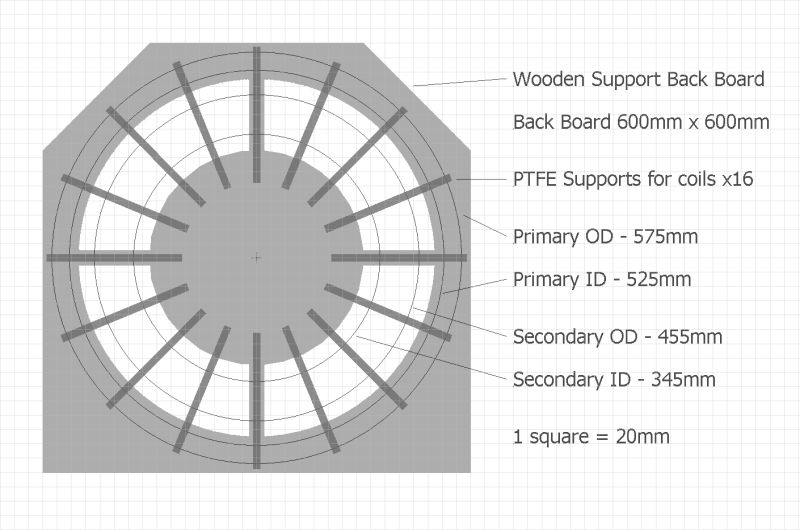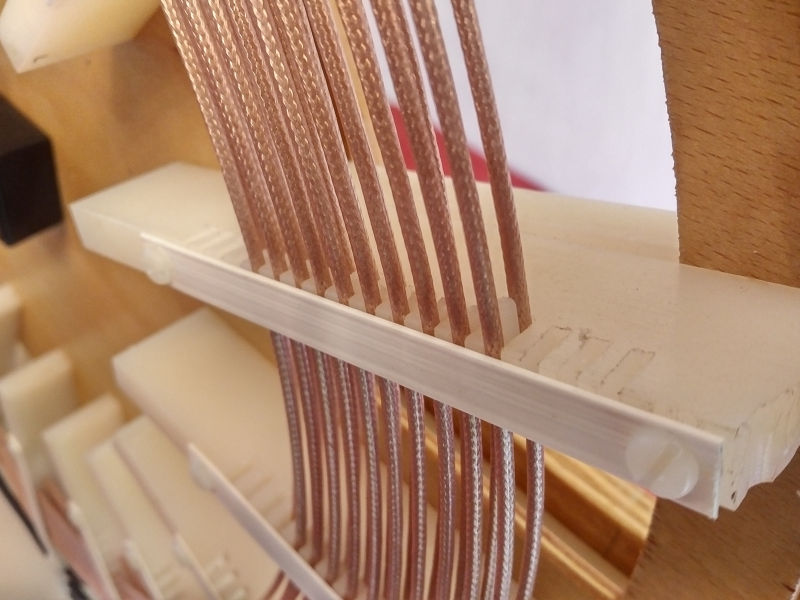The flat, spiral, or pancake coil, applied to the transmission of electric energy was presented in a patent by Tesla[1] in 1900, subsequently investigated by Dollard et al.[2], Mackay et al.[3], and no doubt by others. The design, implementation, and measurement of a flat coil is presented in the following sequence of posts. This coil has then been used in a range of experiments including single wire effects, wireless transmission of power, and investigations into the properties of displacement and transference of electric power. These experiments, and there results so far, will be reported in a subsequent sequence of posts.
Tesla’s original design of the coil is shown in Fig. 1. Designing a flat coil empirically from scratch starts with choosing the required fundamental resonant frequency of the secondary coil. For the purposes of the intended experiments large voltage magnification is not required, and hence the flat coil comprises only Tesla’s secondary coil (λ/4) as a continuous spiral. If additional voltage magnification were required then Tesla’s extra coil[4] (λ/2) could also be added at the top-end or central-end of the coil to make a complete tuned coil (3λ/4 or nλ/4 where n is an odd positive integer). The outer turns of the secondary coil are more closely coupled by induction to the primary coil by virtue of their closer proximity to the primary. The secondary coil, (with or without the extra coil), and in combination with the top-load or termination, accumulates energy induced from the primary and forms a resonant cavity at the designed frequency.
The properties of this resonant cavity are critical to the correct formation of the Longitudinal Magneto Dielectric (LMD) wave (standing-wave) in the coil, which may also be conjectured to be a significant pre-condition for the generation of a displacement event. The properties of the resonant cavity thus formed in a coupled free resonator, and their relationship to the displacement of electric power, will be considered in more detail in Part 2, and further at the experimental stage.
It is important to note that experiments that may include the radiation of electromagnetic energy need to comply with international radio regulation and standards, and so the fundamental operating resonant frequency of the secondary coil is to be set in the 160m amateur radio band (UK standard) in the range 1.810 – 2.000 MHz. As per Tesla’s original design, the coil is to be primarily used in a quarter-wave (λ/4) mode where the top-end or central-end of the coil is a high impedance (in this case open-circuit or connected to a top-load), and the bottom-end or outer-end of the coil is connected to a low impedance (ground, load, or other impedance lowering receptacle).
In this mode the fundamental resonant frequency of the secondary coil is firstly determined by the wire length combined with coil geometry, dimensions, and materials, all which lead to an inductive element in parallel with a capacitive element, or in electrical terms a parallel self-resonant circuit. This will set the free self-resonant frequency at which a 180o phase change will occur in the impedance of the coil. In an ideal parallel resonant circuit this would also be the frequency at which the impedance reaches a maximum. In the practical (non-ideal) case the impedance maximum does not correspond to the frequency of phase change, but is rather reduced due to a range of factors, including:
1. The inter-winding mutual capacitance.
2. The internal series resistance of the coil.
3. Additional capacitive and other circuit loading directly to either end of the secondary coil.
4. The geometry, dimensions, materials and proximity of other conductive/insulating mediums.
5. Conducting extensions to the central and/or outer ends of the secondary coil e.g. adding an additional length of wire to either end of the coil, or a conductive ground plane.
6. The resonant frequency of other closely coupled coils e.g. the primary coil.
7. The wire type used for the secondary e.g. magnet wire, insulated multi-stranded, stranded coaxial sheath etc.
According to the purpose of the experiments to be undertaken using this coil, that is, the exploration of displacement and transference of electric power, the coil geometry will be designed to optimise inter-winding capacitance (coupling). Inter-winding capacitance has been suggested to make a significant contribution[2,3] in the formation of the Longitudinal Magneto Dielectric (LMD) wave in the coil.
With this in mind the geometry of the coil is arranged with two inter-leaved layers of the coil where the number and spacing of the wire turns is arranged in order to maximise the inter-winding capacitive network, whilst keeping the fundamental resonant frequency within the required band. Arrangement of this network is by empirical methods and should ensure that the mutual inter-winding capacitance is not too high, and hence presenting too much of a capacitive load on the coil and reducing the Q, and also not too low and leading to deterioration of the required LMD wave. In other words, the magnetic field of induction and the electric field of induction must be as closely and mutually balanced in the coil as possible. This will be further considered in part 2 as an important pre-condition for the generation of a displacement event.
When the final coil(s) are incorporated into each experimental arrangement fine-tuning of the operating frequency is to be primarily affected by adjustment of the primary coil variable capacitance, and via an adjustable wire extension at the central end of the secondary coil e.g. using a short length of wire, whip antenna, or telescopic aerial. In a parallel resonant circuit, and when the internal series resistance of the coil is significant, the minimum current at resonance occurs at a frequency lower than that expected from the ideal resonant case[5]. In our coil design this series resistance is significant (changing with wire type and geometry) and so also contributes to a reduction in frequency of the parallel resonant impedance maximum.
It is also intended that the resonant frequency of the primary circuit will be used to tune the overall frequency characteristics of the complete coil. This will make it possible to optimise the performance of the coil in a wide range of different experimental conditions including being driven by different types of electric generators (driving the primary coil), as well as attached to a range of different loads (driven from the secondary coil). Adjustment of the resonant frequency of the primary coil causes a corresponding change in the resonant frequency of the secondary coil, and most especially when the fundamental resonant frequency is close for the two coils. The primary coil is intended to be loaded with a variable capacitance in the range 100pF – 1500pF which is suitable for tuning the coil within the desired frequency band, and additionally at frequencies above and below this band.
The accurate prediction by calculation of the self-resonant frequency of a coil is a research topic in itself, and has received considerable investigation, modelling, and experimentation over the years. A detailed theoretical and modelled study of helical resonators has been presented by Corum et al.[6]. An experimental investigation into the properties of coil resonators has been presented by Knight[7], and who introduces a system of analysis and testing that is closely related to the work being undertaken here. In the coil design being considered the required fundamental resonant frequency of the coil is to be established by empirical methods, and combined with fine adjustment when the coil is to be constructed and operated.
Taking into account the described considerations, and when the impedance of the coil bottom-end is lowered by an external length of wire (~2m in length) to establish the correct quarter wave coil mode of operation, the frequency at which the 180o phase change occurs in the impedance of the coil was found to be 2400kc/s. When tuned and loaded with the methods described above this has been found to yield a fundamental resonant frequency within the stated required 160m band. With this point established the required wire length of the secondary was determined to be ~25m in length, arising from 2 layers of 10 turns inter-leaved in close coupling to form a 20 turn secondary coil, and with the following calculated dimensions. A spiral calculator tool[8] was used to confirm these dimensions and wire length before final design and construction of the secondary coil as shown in Fig. 2.
From Fig. 2. two layers of the secondary coil result in a wire length of 25.132m and a secondary conductor wire to spacing ratio of 1:3.2, a ratio that has been empirically found to benefit the formation of the Longitudinal Magneto Dielectric (LMD) wave in this geometry of coil.
The number of turns in the secondary is kept low, in this case 20 turns, in order to minimise excess voltage magnification and step-up which can cause the breakout of discharge streamers from the top load. For the purposes of the investigation of electric displacement of power it is preferred to maximise the generation of the Longitudinal Magneto Dielectric (LMD) wave, and for the case of transference the Transverse Electromagnetic (TEM) wave, by containing as much energy within the secondary as possible, and so avoiding the dissipation of energy by discharge to the surrounding environment.
This concludes the first part of the design of a suitable flat coil, and to be continued in part 2 where the properties of the secondary coil are used to consider the design requirements of a suitable primary coil.
Click here to continue to part 2 of the flat coil design.
1. Tesla, N., System of transmission of electrical energy, US Patent US645576A, March 20, 1900.
2. Dollard, E. & Lindemann, P. & Brown, T., Tesla’s Longitudinal Electricity, Borderland Sciences Video, 1987.
3. Mackay, M. & Dollard, E., Tesla’s Radiant Matter Replication, 2013, Gestalt Reality
4. Tesla, N., Colorado Springs Notes 1899-1900, Nikola Tesla Museum Beograd, 1978.
5. Resonance in Series-Parallel Circuits, Chapter 6 – Resonance, All About Circuits
6. Corum, K. & Corum, J., RF Coils, Helical Resonators and Voltage Magnification by Coherent Spatial Modes, TELSIKS University of Nis, Sept. 19-21, 2001.
7. Knight, D., The self-resonance and self-capacitance of solenoid coils, July 12, 2013, G3YNH
8. Bell, S., Flat Spiral Coil Calculator, DeepFriedNeon
9. A & P Electronic Media, AMInnovations by Adrian Marsh, 2019, EMediaPress
10. Dollard, E. and Energetic Forum Members, Energetic Forum, 2008 onwards.



